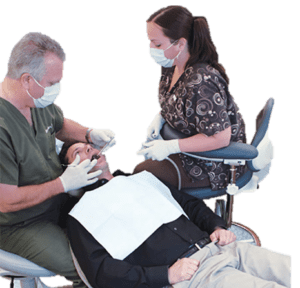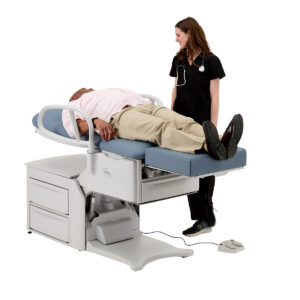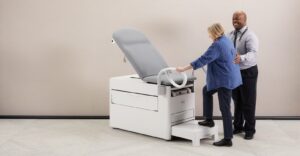Working in the dental field can be a challenging job, requiring you to often stay in uncomfortable positions for hours at a time. To reduce potential injury, ergonomic stools are a great way to provide extra support and comfort when sitting for long periods of time. These specialized stools are designed to promote good posture and keep your spine and back in better alignment. This article will discuss how ergonomic stools can benefit dentists in terms of reducing neck, shoulder, and back pain, as well as other benefits.
What are the Ergonomics of Sitting in a Dental Practice?
 When discussing ergonomics in your dental practice, it’s important to understand the proper way to sit. The ideal position involves sitting up straight, with the feet flat on the floor. The hips should be at the same level or slightly higher than the knees, and the backrest should support the natural curve of the spine. Additionally, if your stool has armrests, your arms should be able to rest comfortably on the armrests without any strain (1).
When discussing ergonomics in your dental practice, it’s important to understand the proper way to sit. The ideal position involves sitting up straight, with the feet flat on the floor. The hips should be at the same level or slightly higher than the knees, and the backrest should support the natural curve of the spine. Additionally, if your stool has armrests, your arms should be able to rest comfortably on the armrests without any strain (1).
Ergonomic stools are designed to facilitate this proper posture. They often feature a saddle-shaped seat that allows the legs to fall naturally, reducing pressure on the hips and lower back. The height of the stool can be adjusted to ensure that the practitioner’s feet are flat on the floor and their hips are at the proper level. Some stools, such as Brewer’s 3300, 9000, 9100, and 9500 series stools, even come with tilting mechanisms or adjustable backrests to further promote good posture.
Ergonomics can help reduce MSDs
The benefits of using ergonomic stools in dental practices are numerous. By sitting in a proper position, practitioners can reduce the risk of developing chronic pain and injuries. This can result in fewer sick days and improved overall health and well-being. Additionally, maintaining good posture can improve concentration and productivity, leading to better patient care.
When selecting an ergonomic stool, it’s important to consider certain factors. The stool should be adjustable to accommodate practitioners of different heights and body types. It should also be sturdy and able to support the weight of the user. Additionally, it’s important to choose a stool with a comfortable seat that provides adequate cushioning and support
In conclusion, ergonomic stools can be a valuable tool in promoting good posture and reducing strain on the body in dental practices. By choosing the right stool and sitting in the proper position, practitioners can enjoy improved health and well-being, as well as better patient care. If you’re experiencing back, neck, or shoulder pain at work, consider investing in an ergonomic stool to unlock its benefits.
Now that we’ve touched on the benefits, lets share some tips on choosing the right ergonomic stool.
What to look for in a dental stool
When shopping for an ergonomic dental stool to reduce back, neck and shoulder pain, there are several factors to consider.
1. Seat
The seat of the dental stool should accommodate your body type and workspace size. A wider, plush seat may be more comfortable for those with ample space, while smaller, sculpted chairs may suit those who are smaller in stature or have limited clinic space. Ensure that the backrest of the dental stool allows your ears, shoulders, and hips to remain relaxed and aligned with one another. The lower back should also have a slight curve to encourage neutral positioning, which keeps muscles and joints loose, flexible, and pain-free.
2. Height
Seating height should be at knee height, with hips slightly higher than the knees. The operator stool should be tilted slightly downward and flat on the floor, with the lower legs in a vertical position.
3. Foot Ring
For individuals who are of shorter stature, a foot ring on the legs of the dental stool offers more support for the lower body. It prevents feet from dangling, improves circulation, and minimizes nerve compression.
4. Body Support
Proper lumbar support is crucial for preventing back pain. Wrap-around comfort provides cradling of the back, offering stability both laterally and at the base of the spine. This feature allows for rotation of the trunk and twisting as needed to fulfill job duties. Brewer’s 9500 series of ergonomic dental stools feature a wrap-around backrest for optimal body support.
Using ergonomic equipment such as dental stools is crucial for preventing injury and promoting comfort during a standard workday. When shopping for an ergonomic dental stool, consider the seat, height, body support and whether you need a foot ring or not. With the right ergonomic dental stool, dental professionals can unlock the benefits of reduced back, neck, and shoulder pain in dentistry.
If you would like to discuss your practice’s health and what seating is right for your team, reach out to us at 262-251-9530 or fill out a request a quote on our website.
If you would like to discuss your practice’s health and what seating is right for your team, reach out to us at 262-251-9530 or fill out a request a quote on our website. Or research dental seating on your own on our Dental Professionals page.
Other articles in our dental seating series:
Article 1: The Painful Truth: Why Dental Professionals are so Susceptible to MSDs
Article 3: Don’t Settle for Cheap: Invest in Quality Dental Stools for Maximum Comfort and Health
(1) “Seating and ergonomics.” Cambridge University Hospitals, 05 Oct. 2020, https://www.cuh.nhs.uk/patient-information/seating-and-ergonomics/
Explore Brewer dental seating
Whether you want traditional, saddle or assistant seating - we have the perfect stool for you.




